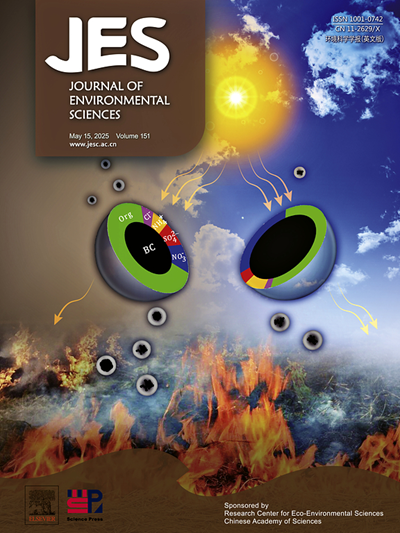北京地区甲醛对气象的响应:主要或次要贡献
IF 5.9
2区 环境科学与生态学
Q1 ENVIRONMENTAL SCIENCES
引用次数: 0
摘要
在夏季高温时期,甲醛(HCHO)水平由于二次生产而增加。然而,最近的研究也表明冬季HCHO浓度升高,但根本原因尚不清楚。通过对北京城区的HCHO观测,探讨了冷暖季节气象差异对HCHO浓度的影响。此外,将正矩阵分解模型应用于HCHO的源分配,重点关注污染事件期间的变化。结果表明:暖季HCHO的二次生成受低压锋影响下的高温驱动,二次生成+背景的贡献在下午达到峰值85.9%,呈单峰型日变化;反之,在寒冷季节,均匀压力场的影响,加上弱风、低边界层和高湿,导致一次排放的HCHO积累,形成多日高浓度污染。在污染最严重时期,人为一次排放贡献率高达91.7%。因此,虽然已认识到挥发性有机化合物通过二次生产对HCHO水平的贡献,但不能忽视寒冷季节一次排放的重大影响。本文章由计算机程序翻译,如有差异,请以英文原文为准。
Response of formaldehyde to meteorology in Beijing: Primary or secondary contributions
During high-temperature periods in summer, formaldehyde (HCHO) levels increase due to secondary production. However, recent studies have also shown a rise in the HCHO concentration in winter, but the underlying cause remains unclear. Here, HCHO observations in urban Beijing were conducted, the impact of meteorological differences between warm and cold seasons to HCHO concentrations was investigated. Additionally, the positive matrix factorization model was applied to the source apportionment of HCHO, with a focus on changes during pollution events. The results indicated that, during warm seasons, the secondary production of HCHO was driven by high temperature influenced by the low-pressure front, with the contribution of secondary production + background peaking at 85.9 % in the afternoon, exhibiting a unimodal diurnal variation. Conversely, during cold seasons, the influence of a uniform pressure field, coupled with weak winds, low boundary layers and high humidity, led to HCHO accumulation from primary emissions, resulting in multiday high-concentration pollution. During the most severe pollution periods, anthropogenic primary emissions contributed up to 91.7 %. Therefore, while the contribution of volatile organic compounds to HCHO levels through secondary production has been recognized, the significant impact of primary emissions during cold seasons cannot be overlooked.
求助全文
通过发布文献求助,成功后即可免费获取论文全文。
去求助
来源期刊

Journal of Environmental Sciences-china
环境科学-环境科学
CiteScore
13.70
自引率
0.00%
发文量
6354
审稿时长
2.6 months
期刊介绍:
The Journal of Environmental Sciences is an international journal started in 1989. The journal is devoted to publish original, peer-reviewed research papers on main aspects of environmental sciences, such as environmental chemistry, environmental biology, ecology, geosciences and environmental physics. Appropriate subjects include basic and applied research on atmospheric, terrestrial and aquatic environments, pollution control and abatement technology, conservation of natural resources, environmental health and toxicology. Announcements of international environmental science meetings and other recent information are also included.
 求助内容:
求助内容: 应助结果提醒方式:
应助结果提醒方式:


